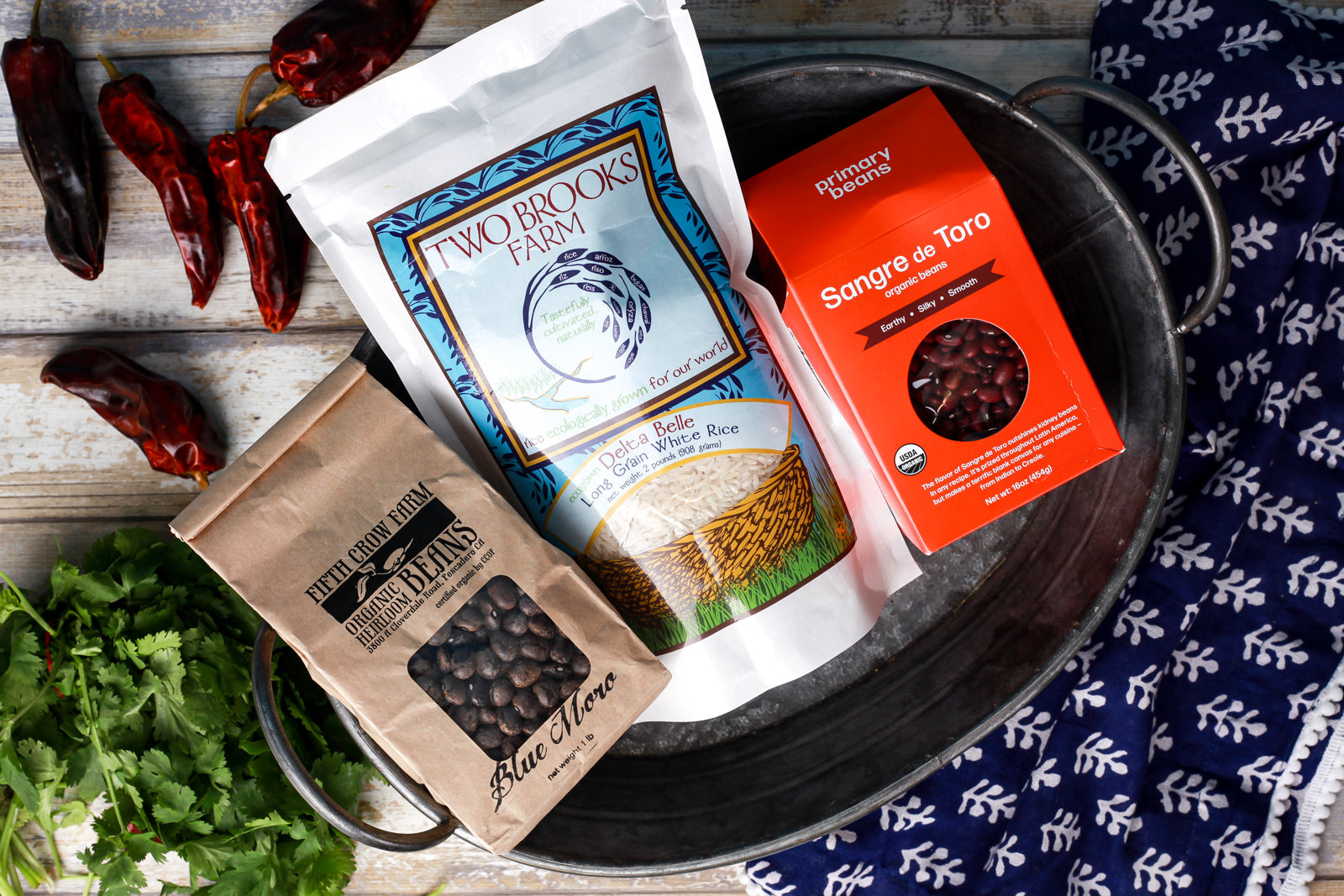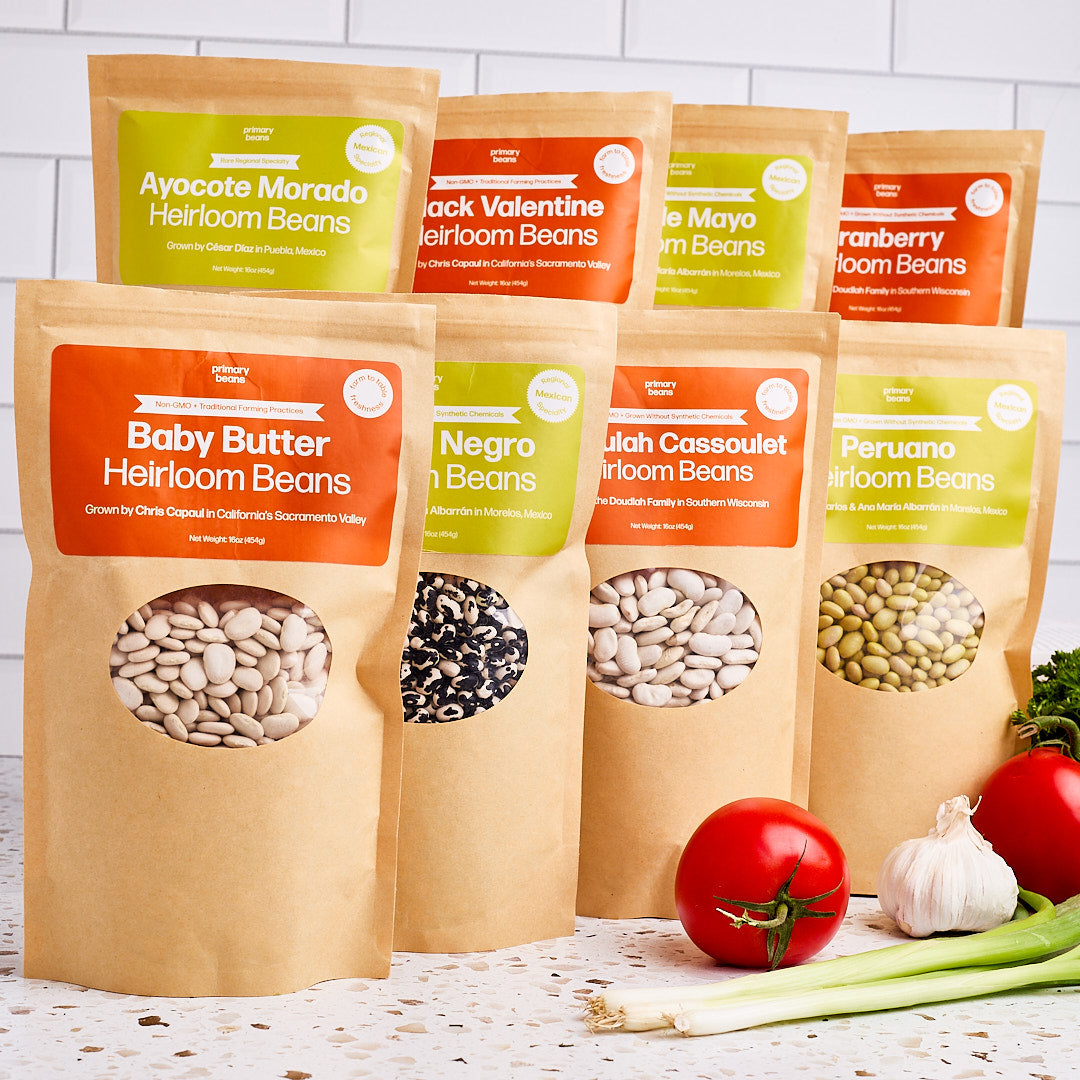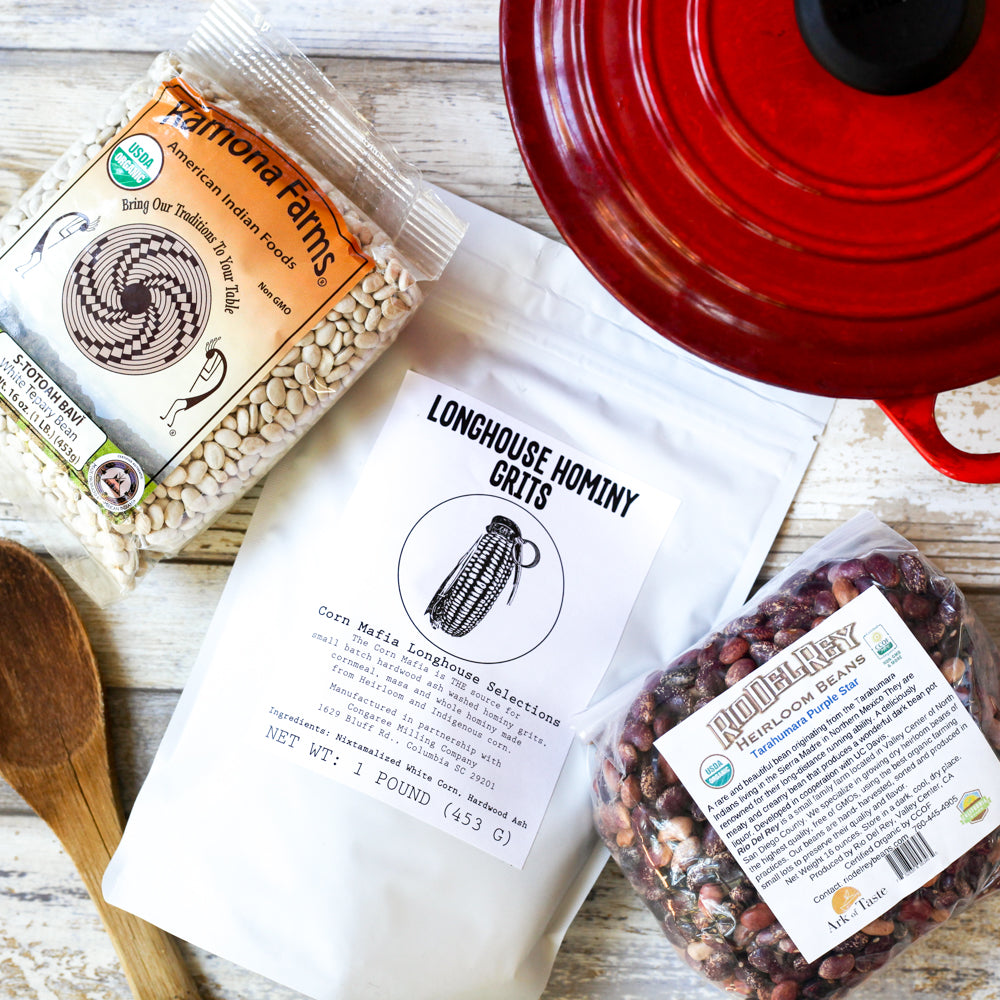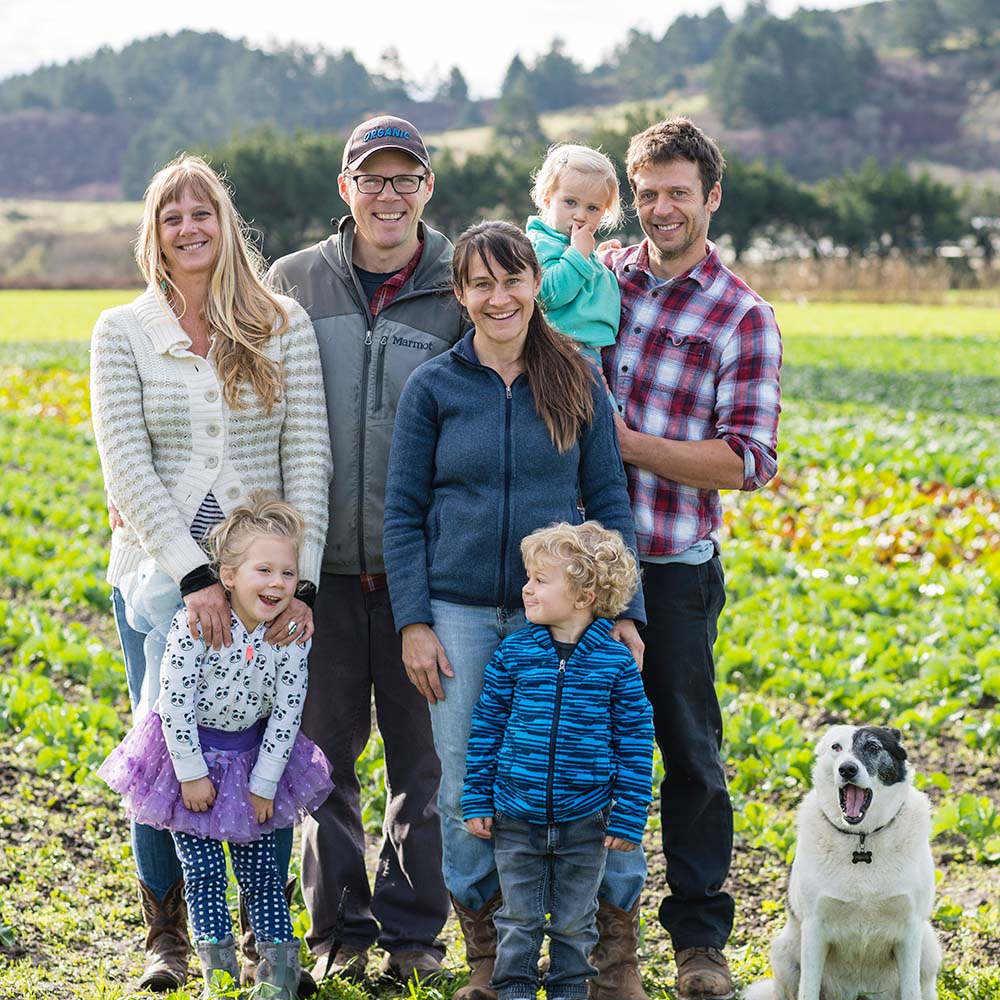10.99 FLAT RATE SHIPPING
10.99 FLAT RATE SHIPPING
SHOP

June 2023 Heirloom Bean and Grain Club
June 15, 2023 7 min read
This month we are going to explore the rich culinary tradition of rice and beans with two of our favorite heirloom varieties of beans specifically used in distinctly different bean and rice dishes.
I know, we just had rice last month. We don't ordinarily send out similar ingredients so close together but trust us, this one is distinctly different and you'll be so thankful to have it in your fridge (don't forget to store grains in the fridge not the pantry!) If you're one of our bean only members, you will delight in the rare Tom Phipps Beach Pebbles.
THE BEAN AND GRAIN BOX CONTAINS:
Organic Sangre De Toro Beans, Organic Blue Moro Beans, Regeneratively Farmed Delta Belle Rice
THE BEAN ONLY CONTAINS:
Organic Sangre De Toro Beans, Organic Blue Moro Beans, Organic Phipps Beach Pebbles Beans
ORGANIC SANGRE DE TORO BEANS
These rare, long, flat beans are named "bulls blood" from their deep red hue. Usually found in kitchens throughout Latin America, the color adds a greater amount of antioxidants when compared to other beans from the area. The skin thins when cooked and almost melts in your mouth. Sangre de Toro beans are dense but without starch, a perfect pantry staple.
WHAT TO DO WITH THEM
Use these in any recipe that calls for red beans. One of my new favorite recipes is our take on red beans and rice. This 100% vegan version of the cajun classic will fool even the most ardent meat eaters! It's been tested and approved by our Baton Rouge taste testers. We're ditching the traditional ham and sausage and replacing it with umami filled kombu. The natural glutamates in the kombu enhances the flavors of the dish like mother nature's MSG and the umami mimics the meat products nobody will ever miss them. All the flavor, none of the carcinogenic meat products. Did you know that the World Health Organization recently categorized bacon and sausage as carcinogens?
ABOUT THE MAKER
Primary Beans is a brand-new, sister-founded purveyor of single-origin dried beans from recent harvests on a mission to place the almighty bean at the forefront of meals that are good for people and the planet.
Linsey and Renee are fifth-generation Arizonans from a small town on the Mexican border. Like any border town kids, they grew up around the culture and flavors of Northern Mexico. Early on, they developed a deep appreciation for beans and were the kids asking for “no rice, only beans please” at the local restaurant.
Turning their passion into a mission, the sisters created Primary Beans to deepen our connection to the food we eat and the land it comes from. They ethically source fresh, delicious beans from their network of family farms to deliver them to your table.
ORGANIC BLUE MORO BEANS
This very rare bean comes from Brazil. It's one of those beans that is so beautiful you don't know if you should cook it or put it on the table as a centerpiece. The dappled steal blue color is striking. Don't be tempted to leave them in the pantry or turn them into jewelry though because you'll be missing out on a rare treat. The moro is like a cross between a pinto and a black bean with a creamy dense texture and thin skin. The flavor is closer to a black bean with earthy undertones and a broth so velvety and delicious you'll be lapping it up. Fifth Crow Farms got their hands on the seeds for these gems from Brazil through a seed exchange and they are growing them organically.
WHAT TO COOK
Brazilian Beans is somewhat of a national dish. Different from traditional Latin bean dishes with cilantro and lime, this uses white wine vinegar and parsley, more European ingredients from the Spaniards that settled in the region. You may want to enjoy the national drink of Brazil with it, the caipirinha. Brazilian beans are very similar to the cuban favorite, Moros Y Christianos (Moors and Christians, so named after the dark beans and white rice).
BRAZILIAN BEANS

1lb of Blue Moro Beans
6 Cups of Water or vegetable or chicken stock
2-3 bay leaves
olive oil
1 yellow onion chopped
3 cloves of garlic, diced
3-4 Tablespoons of white wine vinegar (we like the chardonnay or rosé by American Vinegar Works)
1/4 Cup diced parsley
salt and pepper to taste
2 Cups Delta Belle Rice
Directions:
1. Soak the beans then cook in a large pot with water and a liberal sprinkle of salt and bayleaves until tender (about hour), or cook them from dry in a pressure cooker on high for 40 minutes. If using a pressure cooker reduce the amount of liquid. You need just enough to cover the beans with an inch to spare. This step can be done up to 3 days in advance, just refrigerate the cooked beans in their liquid until you are ready to make the rest of the recipe.
2. Begin cooking your rice. I sort of cheated and used Carolina Gold Rice because it's so darn delicious, but long grain white rice is traditional.
3. While the rice is cooking, cook the bacon (if you are using) in a pan until the fat renders and it starts to brown. Pour off all but a tablespoon of fat, add the onion and sauté until tender, add the garlic and sauté another minute, adding olive oil as needed to keep the mixture very moist.
4. Mix the onion and garlic mixture with the beans including their liquid and add the vinegar. Cook for 5-10 minutes to meld the flavors and warm the beans if they had been in the fridge. Take a 1/2 cup of the beans and liquid out and blend them in a blender then mix back into the dish to increase the thickness of the broth. Add the parsley, taste, add salt and pepper and additional vinegar if needed. Serve with rice.

ABOUT THE FARMER
Fifth Crow Farms is an organic family owned farm in Pescadero, California. Grounded in a values-based approach to land stewardship, Fifth Crow Farm is a dynamic and diversified organic farm in Pescadero, CA. Founded in 2008 with a shoestring budget, a supportive local community, and ambitious dreams, they strive to bring eaters the highest quality, best tasting, and most nutritious food possible.
Fifth Crow Farm wants their farm to be more than a business: they strive to make it an engine for positive change in the food system. They are stewarding the land in a way that not only respects but improves habitat for wildlife and builds better soil for future farmers. They also believe in creating a healthy, fulfilling, and fair work environment, and providing their customers with the best tasting, most nutritious, highest quality food possible.
REGENERATIVELY FARMED DELTA BELLE RICE
When we created our vegan Red Beans and Rice recipe, the one thing we were missing was a true Mississippi Delta long grain white rice. We found our perfect ingredient in Two Brooks Farm which has taken up the mantle from their friend and neighbor, the famed Delta Blues Rice which is no longer available. With a buttery, sweet flavor and a springy chew, it is the most delicious long grain white rice we've ever tasted. Perhaps it's the rich mineral content of the bayou soil at Two Brooks Farm that makes it exceptional. Maybe it's their regenerative practices or the Non-GMO seeds they sow on the family farm that make it special.
A Brief History Of Rice In The US
Rice was first grown in the US in the Low Country of South Carolina and Northern Georgia. Carolina Gold Rice was brought to the US from Africa and cultivated by enslaved people. This distinct rice became the staple of regional dishes like Hoppin' John. After rice farming became industrialized rice production moved to the Delta region and new varieties of long grain rice were favored. In California, short grain rice from Japan became an essential ingredient for the region used by the large Japanese American population.
HOW TO USE IT
Delta style long grain rice is traditional in Mississippi and Louisiana dishes ranging from étouffée to jambalaya.
ABOUT THE FARMERS

Two Brooks Rice is the product of years of reflection on our food production systems and how those impact our natural world. As a 10th generation farming family, Lawrence, Abbey and Sarah live and farm on the bayou in the most charming of Mississippi’s small towns-- Sumner. Theirs is a farm that lives in harmony with nature, giving back more than it takes. They practice no-till farming, they use no pesticides and they capture rain water and runoff to conserve our water resources. “Years ago, after watching the overwintering waterfowl population explode, and the benefits they give to the land, after watching the eagles roost around, after watching the deer population go up, I started thinking about what I was doing. I started thinking about the soil microbiology and biology. How, by the fact that we had curtailed tillage and allowed waterfowl to do the tillage, we were beginning to rebuild the soil structure with naturally living organisms that enhance the rice plants health, and require far fewer synthetic inputs (to this day I use no insecticides or fungicides).”
ORGANIC TOM PHIPPS PEBBLE BEANS
Fifth Crow Farms is keeping this unique local variety, and the legacy of Tom Phipps alive. Tom started farming in 1969, growing

artichokes in the cool foggy climate of California’s central coast. It was a desire to farm without pesticides that converted Tom into a bean-thusiast. He grew over 60 varieties of beans organically in Pescadero, California. People traveled far and wide to purchase his beans from the famed Phipps Country Store. He was so well known for his heirloom beans that the New York Times wrote an article about he and his wife, Valerie in 1997. The Phipps supplied restaurants like Chez Panisse with their amazing beans. One of his most popular was a variety that he cultivated himself. He called them Pebble Beans because they resembled beach pebbles. After Tom passed away his neighbors at Fifth Crow Farms wanted to keep the memory of Tom and and his beloved Pebble Beans to live on. We are very fortunate to be able to offer you a chance to try a truly local bean.
While it looks like all the beans are different varieties, when sown, the plants all look the same and mature at the same time and have the same cooking time. Pebble Beans are beautiful little beans that are dainty in size but pack a delicious punch of flavor. They have thin skins and cook up quickly with a smooth, creamy texture.
Recent Articles
About Us
Foodocracy is dedicated to creating a more sustainable and independent food system. We support small, independent farms across the nation.
Get impossible to find beans and grains shipped direct to your doorstep each month from small family farms.
We support small, family owned farms across the nation. Did you know that farmers only make an average of 10 cents on every dollar you spend at the supermarket? Working directly with farms and not middle men ensures that more money goes back to the people actually growning your food.
Get 10% Off
Sign up for delicious recipes and special offers.
**Regularly priced items only.




